Last updated 10 June 2020
Where to stay on the Mekong Delta
Tourists are drawn to Ho Chi Minh City because of its history and culture, but the city’s hustle and bustle can be overwhelming. Consider escaping to the Mekong Delta where the pace of life is much slower.
I can clearly see Ben Thanh Market’s belfry and clock. It’s across the road, only two lanes of traffic wide. A distance of fewer than 20 meters separates me and the market’s entrance. But it may as well be the Amazon River I’m considering crossing. Scooters, motorbikes, trucks, cars, and cyclos whiz past me in a never-ending procession, I’m concerned about stepping into the traffic chaos. There are no pedestrian crossings. But even if there were, I know Vietnamese people don’t stop for pedestrians. Before arriving in Vietnam, I’d received instructions on how to cross busy Vietnamese roads. Step into the traffic without hesitation and the traffic “magically” weaves around you, if you stop that’s when you’ll strike trouble (I was told.) I’d arrived in Hanoi 10 days earlier and remember my heart palpitations when crossing my first Vietnamese road. The nerves, while not as bad, were still present in Ho Chi Minh City, at the end of my Vietnamese holiday.
The capital of the country and the main commercial and economic hub for Vietnam, Ho Chi Minh city is busy and fast-paced. Over the last decade, overseas investors have injected vast sums of capital into the city, transforming the once low rise cityscape, to one with architecturally imposing high rise buildings, international five-star hotels, and apartments.
With nine million people and over six million motorbikes bursting onto the city streets at all hours of the day and night, it appears constantly chaotic. At the tail end of my two-week Vietnamese holiday, after a couple of nights in Ho Chi Minh City (or Saigon the locals’ reference), it was time for me to escape this historically fascinating but chaotically crazy place. Being a Brisbane lass, not fond of large cities, I wanted to swap the chaos for a unique Vietnamese experience.
My destination: the Nguyen Shack in the Mekong Delta region.
About the Nguyen Shack
The Nguyen Shack offers a compromise between a hotel and a homestay. The owners, husband Maxime (French Canadian) and wife Theu (Vietnamese local) wanted to create a place where you avoid feeling that disconnect from the country and the environment, as you often do in Hotels and resorts. The Nguyen Shack was built from locally sourced materials using only eco-friendly sustainable products. Ex- Londoner Alexia Hollinshead 33yo, the manager during my stay indicated the owners hoped guests would feel like they’re staying in a home away from home.
Cai Rang is approximately 20 minutes from Can Tho city. To get to the Nguyen shack, my tip is to make sure to have the address written in Vietnamese. It’s off the beaten track and is not clearly signed. The driver who collected me from my Saigon Hotel had to stop several times in Cai Rang asking for directions. Thank goodness for mobile phones!
Another option is to catch a bus from Saigon, then a taxi from Can Tho. A few guests during my stay at the shack said they’d successfully used public transport to the Nguyen Shack.
The amenities
The Nguyen Shack has three individual free-standing bungalows over-looking the water. They also offer four-bed basic dormitory rooms and rooms with a shared bathroom. Access to these rooms is via a 20 metre long swinging bridge.
Clambering up a steep set of stairs, I was in my own private open-air treehouse with a double and single bed.
Don’t expect to be able to lock yourself in at night time. There are no doors. The bungalows are fitted with the basics including a bathroom (draw a cloth curtain across for privacy), bar fridge and fans. At the time of my departure security safes were being installed in each room. There is free wifi but no mod cons like a hairdryer or air-con.
Does the Mekong Delta have mosquitoes?
The floor fans provide much-needed air circulation as the days are hot and humid – this is southern Vietnam after all. The best place to escape the heat was in one of the two silk hammocks on the edge of my balcony overlooking the river. On the first afternoon, I succumbed to relax mode, laying in one of the hammocks for a few relaxing hours with a book and a cool drink.
Every now and again the stillness was disturbed by a passing boat making their journey up or down the river. Families with their purchases from the floating markets and workers transporting their motorbikes. It was an assortment of local life on the Mekong and the perfect way to decompress from the craziness of Saigon.
I would have laid in my hammock happily for many hours watching the dancing fireflies light the evening sky in swirling pinpricks of light. But feeling the unmistakable bite of something on my skin stopped any thoughts of resting any longer. I’ve been exposed to mosquitoes in my travels but nothing quite prepared me for the viciousness of the variety hovering about the Mekong. Determined little critters, their bite penetrated my sarong.
With nowhere else to go, I was forced to unfurl the mosquito net above the bed, taking cover under its protective shroud. I considered staying there for the night, but the pangs of hunger, aroused by the smell of food wafting in from the kitchen next to my bungalow meant I had to leave my safety net. Thankfully the communal dining room’s portable fans and a few squirts of Alexia’s insect repellent kept the mosquitoes away. Alexia recommended a refreshing lime juice drink. I slurped on the pleasantly sweet concoction, as I perused the extensive menu. Everything looked tantalisingly good. I ordered grilled beef rolls in homegrown betel leaves. They were devoured with another lime juice.
It was very relaxing, dining above the river at night, chatting with a handful of guests listening to their day’s adventures. The mosquitoes were a distant memory.
Relaxation
There are no regimented hours for dining and activities are optional at the Nguyen Shack. Guests may wander into the dining area at any time and request meals. Not following a strict time routine times provides the chance to truly relax. A guest I met in the dining area had succumbed to this “state’ of relaxation. An Australian, living and working in Saigon for the past four years, Sally was in the midst of a solo cycling adventure around the region. I asked her how long she intended to stay at the Shack.
“I’m not sure,” she replied. “I keep extending my departure date.”
Activities
The Nguyen Shack offers a number of activities including a floating Market tour ($12USD / person at time of publishing in 2014); a Guided Bike Tour ($10US/person) and an afternoon Boat Tour ($6USD per person.) Should you feel inclined to venture out on your own journey of discovery around the side streets and into the neighbouring villages, push bikes are available for guests to use at any time.
Before heading out for a three-hour bike ride, I enjoyed a breakfast of Vietnamese pancakes. Forget the Western flat version, these were cups of delicate pastry filled with savoury goodies – the perfect way to carb up for the efforts ahead.
Linh who served my breakfast pancakes was our tour guide. Joining us was a German couple and a family from America (Mum, Dad, 13 and 7-year-old sons.) Our first stop was at the small two-roomed local village school, followed by a visit to the ironmonger’s workplace. Both places were empty because it was a Saturday. We were fortunate the ironmonger was not at work as the small space with the thatched roof had no provision for ventilation and felt very claustrophobic and smoky.
“Century-old iron mongering traditions are handed down from father to son and are still in use today,” said Linh. “They are not likely to change.”
We stop at the village’s medicine man/Chinese herbalist shop. The entrance of the small room is lined with timber shelves crammed with wooden boxes filled with indescribable herbs and odd shaped items. The dark timber drawers look like they have been in use for over 100 years. This wizened old man, sitting beside a desk covered with herbs, gestures to me to sit on the chair next to him. He takes my pulse, pressing his long bony fingers gently onto my wrist.
The smiling gaze of Ho Chi Minh looks on from a framed picture on the wall. The medicine man stares intently into my eyes and picks up a Western medical device, wrapping my upper arm he takes my blood pressure. I smile and he smiles back. No words are spoken.
A quick discussion occurs between Linh and the man and Linh tells me no herbal concoction is suggested.
I presume I’m in great health?
Our next stop is the local pagoda where we meet six orphaned local children, who are cared for by the monks. The youngest orphan is only nine months, and we meet him in the kitchen, sitting upright on a flat wooden platform. An elderly monk sits opposite. Cross-legged, he is feeding the baby from a small bowl.
More of the orphaned children meet us outside, showing cheeky shy smiles at the strangers in their midst. As we walk towards our bikes, they wave and giggle, begging for more of the sweets we shared with them earlier.
We ride further along a village path until Linh indicates to stop. We’re outside a domestic house that gives little indication of what is going on out the back. Linh explains it’s the local rice wine distillery. This elaborate set up has large vats and numerous pipes twisting and turning between them. Linh explains the local price for three litres of rice wine is about 60,000 dong ($2USD.) The cheap price explains the proliferation of these back yard setups
The final stop on our bike tour is at a rice factory, where Linh explains how they care for the environment, using leftover components of rice on garden beds.
With the humidity creeping uncomfortably high, we cycled back to the Shack where my cold shower felt so good. A few hours chilling in the hammock gave time to reflect on the everyday life of Vietnamese rural people.
Floating markets of Cai Rang
My trip to the Cai Rang region was organised specifically to visit the floating markets. I’d heard these markets were more popular with locals and less touristy than the floating markets further up the river at Can Tho. The markets are where the Mekong river people ply their trade – seven days a week.
Despite the 5.30 am early start, I felt excited. A quick 20-minute boat ride along the murky waters of the quiet estuary, past the homes of many river dwellers, brought us out to the main tributary.
The quiet quickly gave way to a hive of activity, a dense conglomeration of boats and people. We pass boats big and small, noticing many specialise in a particular fruit or vegetable. Some boats appear so derelict I wonder how they’re still afloat.
“It is the Vietnamese way to recycle absolutely everything, especially their boats,” says Alexia, our tour guide for the morning. “And the fruit or vegetable impaled on a tall spire a few metres above their vessel advertises their boat’s specialty.”
How very effective!
I watch as the crew on larger boats skilfully transfer their cargo of watermelons, tossing them one by one to the crew on the smaller boats. These smaller boats, once they’re loaded, travel upriver to the markets in Saigon.
Food vendors float past offering noodle soups and bakery products. I ask Alexia about a boat selling banh style bread. She beckons the boat and it pulls over next to ours and rolls of fresh sweet banh bread is handed over by the smiling toothless female vendor. (Less than 50 cents!)
With the floating markets finishing at 8 am, we make our way to the land market.
Australian chef and author Luke Nguyen who grew up in Vietnam said the Vietnamese love their produce super-fresh – alive where possible. He wasn’t wrong. We walked past stalls with freshly cut beef lying in the open air, sunshine (and resident flies!)
The young group of Germans on my tour watched fascinated as a lady cut up frogs (or toads) as they were still kicking. (Now that’s fresh!) I was fascinated by a stall vendor as she expertly cut up a long length of something white.
“Fresh tofu,” explains Alexia. “We buy ours here each morning for our restaurant and it is amazing.”
We tasted rambutan fruit, picked from the trees that morning. I declined to try the bitter cucumber. These markets were refreshing for their lack of tourists and zero harassment to buy – a pleasant change after my experience at Saigon’s Ben Thanh Markets.
The Verdict
Mekong reviver
The Mekong Delta is made up of hundreds of waterways. My decision to escape Saigon for a few days and experience life on one of them was a good one. The Nguyen Shack is off the beaten track and the food and accommodation are basic – but if you’re looking for a genuine Vietnamese experience, this is the place to find it. The tofu is amazing – unlike any tofu I’ve tried before. And don’t worry about the mosquitoes – bug spray sorts them out.
Disclaimer: I travelled independently and was not paid or sponsored for this post. All opinions expressed are mine.
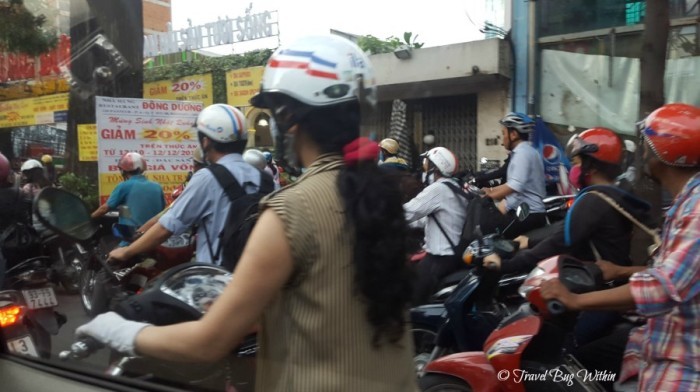
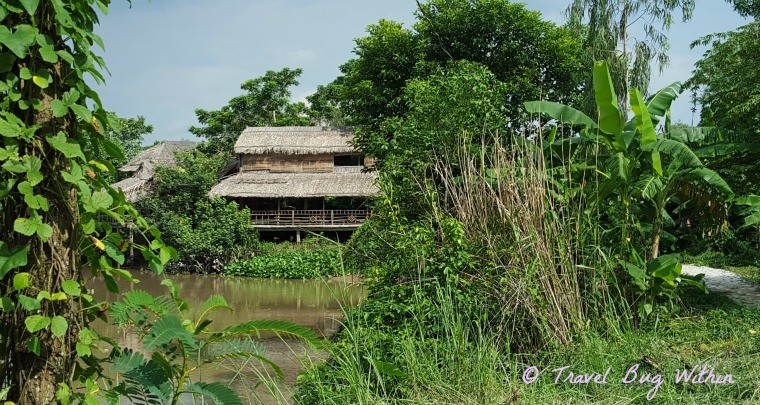
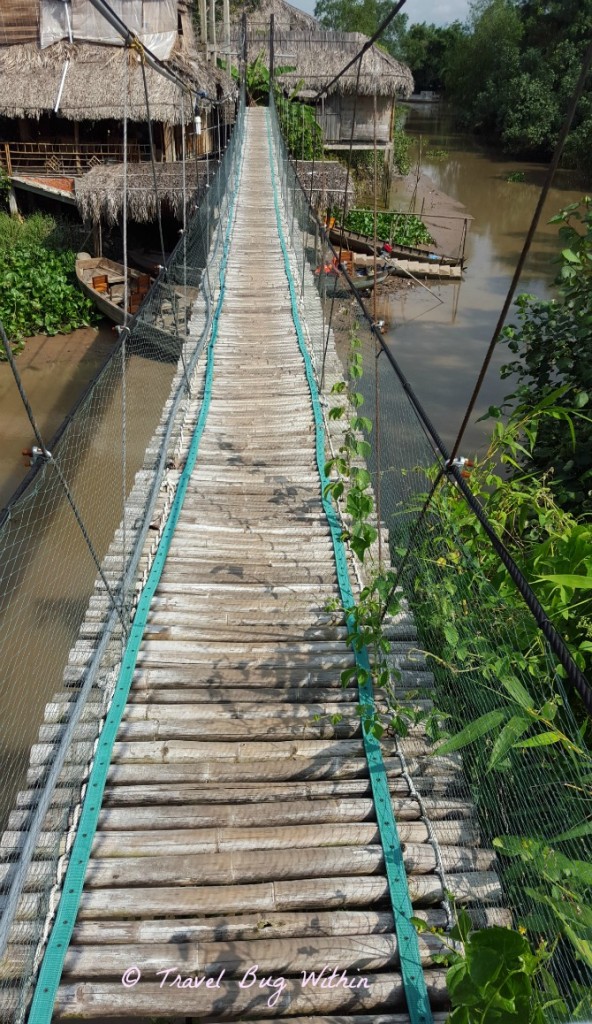
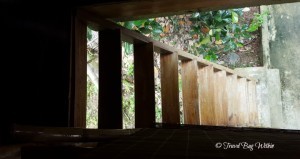
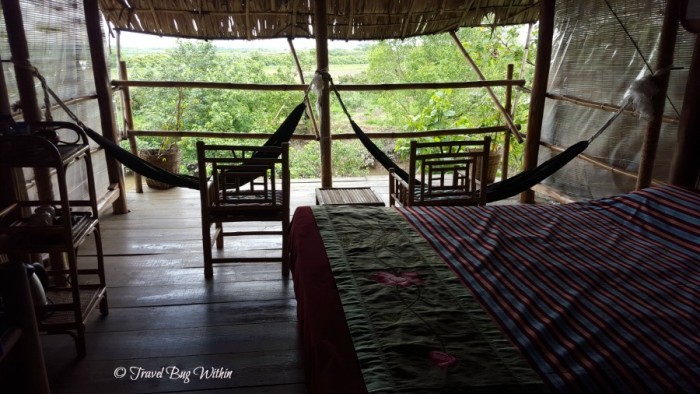
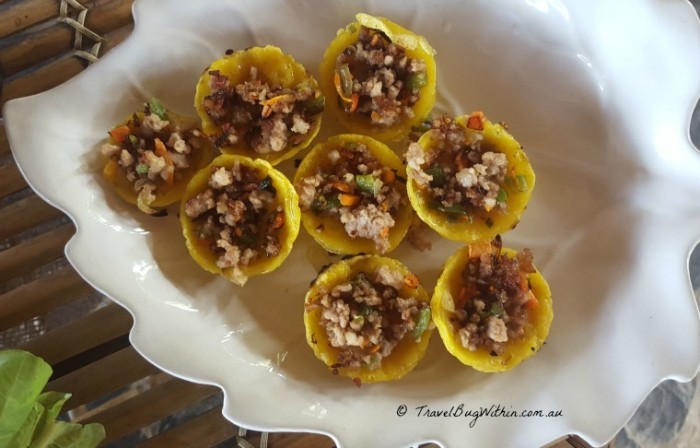
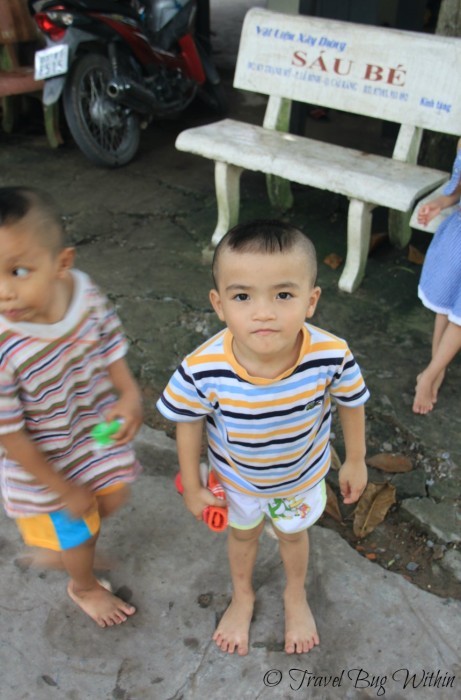
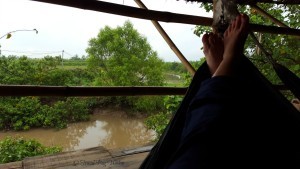
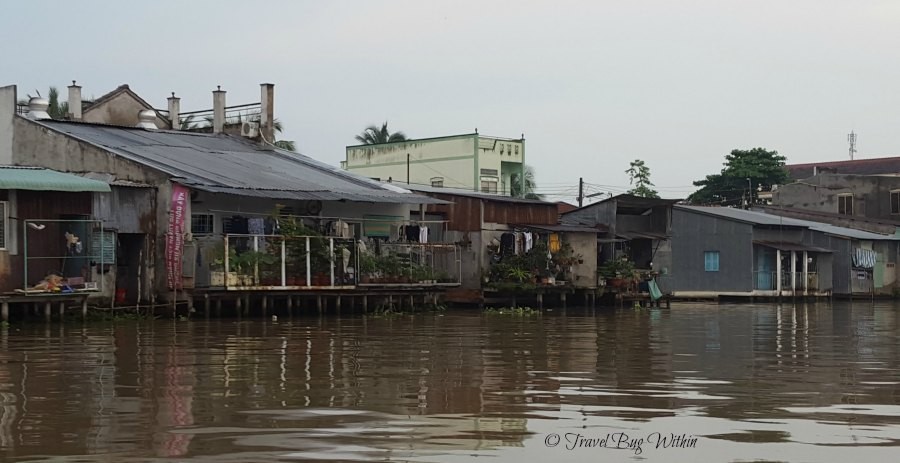
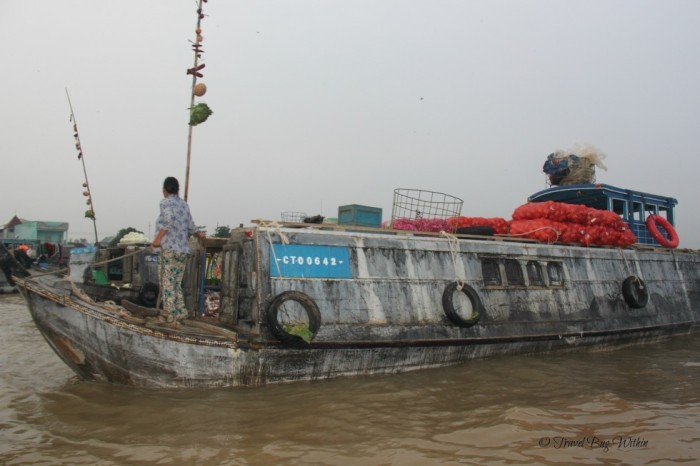
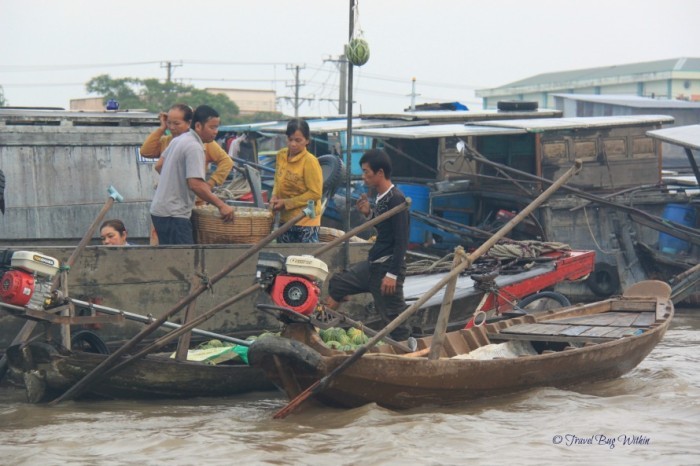
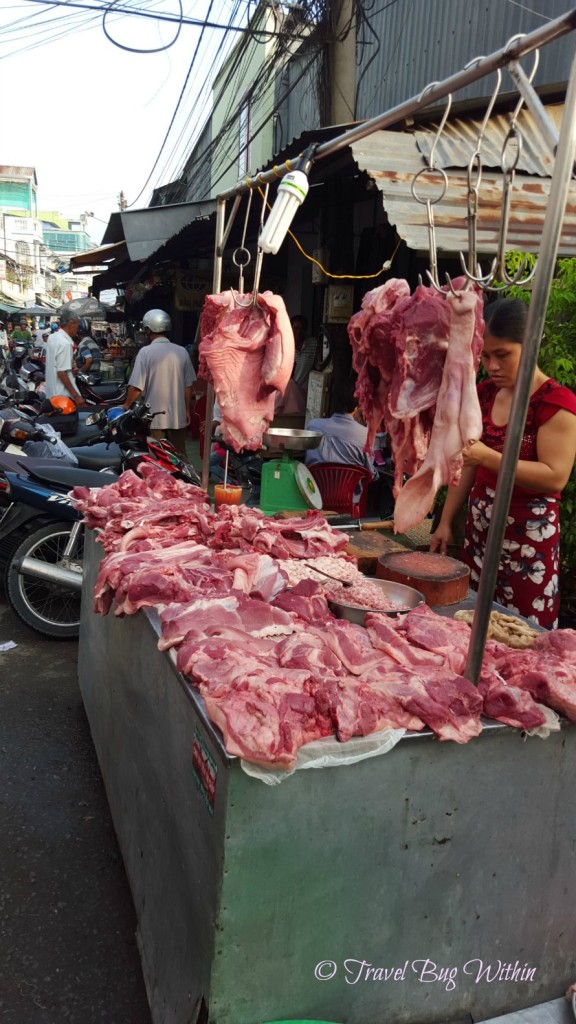
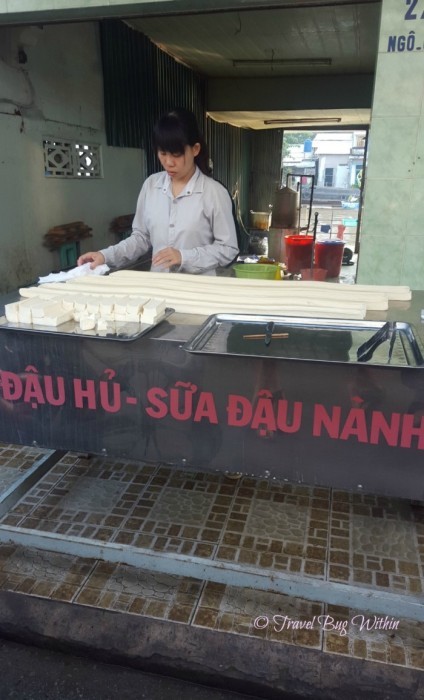
Great article Jenn. Vividly remember stepping into the traffic in Saigon for the first time, under inducement from my hosts, who stepped fearlessly out into the flow, dragging me behind them. Far more scary was a crazy ride as pillion on a motor scooter travelling at extraordinary speeds across the city in order to get breakfast. Then being driven in an official government car who simply played chicken with any oncoming vehicle no matter the size. All faith put into the communist party flag flying from the bonnet.
Wow Jen … that’s an awesome reflection of your time at the Nguyen Shack. What an interesting find that turned out to be for you. So glad the medicine man found you in good shape … this means there’s no reason not to have loads more adventures ahead. xo
Thanks Caroline – still not sure about whether I was healthy or not in the medicine man’s eyes! Hoping for many more adventures! xx
Thanks Greg. The traffic experience was still daunting two weeks into the tour! I never braved the pillion ride – only behind a cyclo cyclist and that was close enough in the thick of the traffic. Maybe the communist party flag was your saving grace?! Jenn